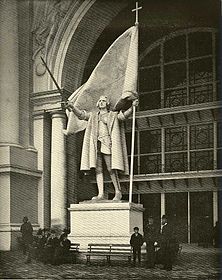- Mary Lawrence
-
See also: Mary Lawrence (actor)
 Columbus at the World's Columbian Exposition, 1893
Columbus at the World's Columbian Exposition, 1893
Mary Lawrence [Tonetti] (1868–1945) was an American sculptor. Lawrence was born in New York City into a prominent New York family whose ancestors included John Lawrence, mayor of New York City from 1673–1675 and 1691–1692, and the War of 1812 patriot, Captain James Lawrence who died after uttering the words, "Tell the men to fire faster! Don't give up the ship!" The fact that the crew did surrender the ship in no way diminished the captain's reputation.
While in Chicago preparing for the World's Columbian Exposition, sculptor Augustus St. Gaudens recommended Lawrence, who had been a pupil of his at the Art Students League for the past five years, for the task of creating the monumental statue of Christopher Columbus that was to be placed at the entrance of the Administration Building. Although some critics claimed that St. Gaudens, or his brother Louis, had in fact modelled the work, St. Gaudens himself debunked this by stating in his Reminiscences that Lawrence, "modeled and executed it and to her goes all the credit for the vitality and breadth of treatment which it revealed."
However not everyone was happy with the choice of Lawrence for this work. Muralist Frank Millet who had been assigned the position of Director of Decorations for the fair appears to have resented the fact that Lawrence received this choice assignment. This likely was because she was a woman, and women at that that time did not get such commissions. In any case when the work was unveiled and Lawrence was looking at it Millet was heard to say "Lost in admiration, ah?" and shortly thereafter ordered the statue moved from its Court of Honor site to another one by the railway station. This was done, but Lawrence still had powerful allies.
St Gaudens biographer Bruce Wilkens relates that the architect Charles Follen McKim, a founding member of the prestigious architectural firm McKim, Mead and White and a widower, had fallen in love with Lawrence in New York. He had enough sway in Chicago to get the statue of Columbus returned to its former place. Lawrence never forgave Millet, and is quoted as saying, "I could stamp on his face and grind it into the gravel until it bled."[1]
Following the end of the Exposition Lawrence served as an assistant to St Gaudens, helping him in the creation of the General John A. Logan monument that was bound for Grant Park in Chicago. Thereafter she moved to Paris where she studied at the Académie Julian. There, in 1893 she met a young assistant to Frederick William Macmonnies, Francois ML Tonetti. They were married in 1900 in New York City. Saint Gaudens, when he heard about the wedding "broke down and wept"[1] and bemoaned the loss of her artistic ability to a much less talented sculptor, saying that she would likely have "lots of festive children," but would produce no more significant art, a prediction that was to prove more-or-less accurate.
Nonetheless, Lawrence did produce a few more works after her marriage, notable two fountains that she did with her husband for the Pan-American Exposition held in Buffalo New York in 1901. In 1907 she contributed two statues, Venice and Spain again in collaboration with her husband, to the parade of statues on the cornice of Cass Gilbert's US Customs House.
References
- Opitz, Glenn B., Mantle Fielding's Dictionary of American Painters, Sculptors & Engravers, Apollo Books, Poughkeepsie, NY 1986
- Rubinstein, Charlotte Streifer, American Women Sculptors. G.K.Hall & CO., Boston 1990
- Saint-Gaudens, Homer, editor, The Reminiscences of Augustus Saint-Gaudens, Published by The Century, New York 1913
Categories: American sculptors | American women artists | 1868 births | 1945 deaths
Wikimedia Foundation. 2010.
